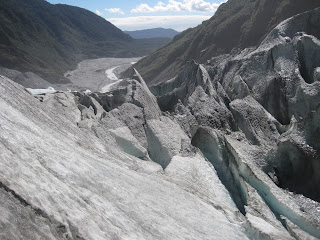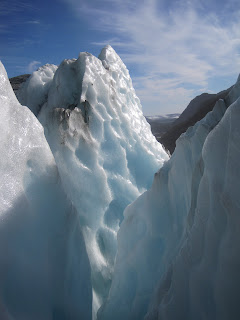Sorry for the recent hiatus in blogging. I have been in New Zealand for the last three weeks at a conference and then doing a bit of travelling around the south island. New Zealand is a beautiful country and, besides being scenic, is very interesting geologically. With this in mind, I decided to share one of the many highlights and do a little research about it.
Here it is:
 |
| The Franz Josef Glacier (March 30, 2011). There is a rock slide taking place out of view on the left that is making things dusty that day. (Photo: Matt Herod) |
I spent a day on the glacier hiking around and ice climbing on the glacier. The guides, who were excellent, gave us lots of basic information about the glacier. Frankly, I was more focussed on climbing than on taking detailed field notes so now it is time to dig a little deeper.
The Franz Josef was named after Emperor Franz Josef I of Austria by explorer Julius von Haast in 1865. However, in New Zealand every place also goes by its name in the Maori language, which for the Franz Josef glacier is Ka Roimata o Hinehukatere meaning "The tears of Hinehukatere". Maori legend for the formation of the glacier is that Hinehukatere loved to climb mountains and convinced her lover Wawe to accompany her. Unfortunately, Wawe, was swept away by an avalanche. Heart broken, Hinehukatere began to cry and her tears froze forming the glacier.
The Franz Josef is a very active glacier. This means that even though it appears to be an unmoving and unchanging mass of ice at any given time, it really is continuously undergoing changes to its shape and movement. In fact, the Franz Josef is one of the fastest moving glaciers advancing or retreating at up to 1000m/year or 0.00011 km/hr, which is a blindingly fast pace for a glacier (Anderson, et. al., 2008).
Over the last decade a number of studies have been done to understand the the response of the Franz Josef glacier to climate change. As one of the most studied glaciers in the Southern Hemisphere the Franz Josef serves an excellent indicator of how climate change will affect glaciers of similar size and dynamics. In order to gauge the response of the glacier to climate change a few key variables must be investigated: changes in ice thickness, ice flow velocity, and comparison of these factors with past data on the terminus position.
Here is a picture of the current terminus.
 |
| The terminus of the Franz Josef Glacier (March 30, 2011) |
 |
| (Hooker, et. al., 1999) |
The causes for the change in terminus position are complex making it difficult to point a finger at any one factor, as is always the case with climate. However, there are several factors, working in concert, that are responsible for the retreat or advance of the glacier. Some of the factors proposed by B.L. Hooker, a researcher from the University of Otago, are that the retreat phase is caused by warmer than average summer temperatures, less precipitation, changes in local wind patterns, more La Nina events, and atmospheric pressure changes. The causes for the advance of the glacier are the opposite of the ones listed above.
Over the last 100 years there is evidence for the occurrence of all of these factors making it impossible to find a "smoking gun" for glacial retreat or advance. The only real conclusion that can be made is that despite ongoing global warming throughout these times the cycle of advance and retreat is controlled by more than just changes in temperature and that despite warming temperatures glacial advance is possible when there are other factors at work.
That is all for now. Thanks for reading.
M
References:
Anderson, B., Lawson, W., & Owens, I. (2008). Response of franz josef glacier ka roimata o hine hukatere to climate change. Global and Planetary Change, 63(1), 23-30.
Hooker, B. L., & Fitzharris, B. B. (1999). The correlation between climatic parameters and the retreat and advance of franz josef glacier, new zealand. Global and Planetary Change, 22(1-4), 39-48.
Here are some cool photos I took of the Franz Josef.



Unbelievably amazing photo's, loved the Maori legend,(I have a book on Maori Legends) very interesting to read about the The Franz Josef Glacier,advancing or retreating at up to 1000m/year! that's incredible....
ReplyDeleteKim R.
I'm learning about the Franz Josef glacier as a part of my A-level study and we're looking into if the glacier's pattern of retreat and advance fits with the pattern of global warming.
ReplyDeleteThis has really helped, thank you.
i used to be a guide on this glacier have you guys considered increased rain fall on the west coast?
ReplyDeleteI'm doing a study on this and I calculated that if this glacier is retreating at up to 1000m/year as you say then over the last 100 years it would have moved 100,000m an that seems highly improbable. On another websites it says that over just the last 4 years it has only moved 500m which does seem slightly more realistic, I was simply wondering if this information is accurate? I may have gone wrong somewhere in my studies and if so I apologise.
ReplyDeleteExcellent information here. I suggest everyone to visit before it's too late.
ReplyDeleteVery Cool
ReplyDelete